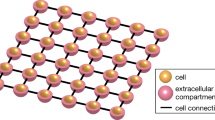Abstract
Modern models of cardiac membranes are often highly complex and computationally expensive, particularly when used in long simulations of spatially extended models of cardiac tissue. Therefore, there is a need for simpler membrane models that preserve the features of the complex models deemed important. This communication describes an empirical procedure that was used to choose the parameters of the three-variable Fenton–Karma (FK3V) model to reproduce the restitution properties of the Courtemanche–Ramirez–Nattel model of atrial tissue. The resulting parameter values for the FK3V model and the sensitivity table for all its parameters are provided. Thus, this study gives insight into the behavior of the FK3V model and the effect of its parameters on restitution properties.
Similar content being viewed by others
References
Courtemanche, M., R. J. Ramirez, and S. Nattel. Ionic mechanisms underlying human atrial action potential properties: Insights from a mathematical model. Am. J. Physiol. 275:H301–H321, 1998.
Crank, J., and P. Nicolson. Practical method for numerical evaluation of solutions of partial differential equations of the heat conduction type. Proc. Cambridge Phil. Soc. 43:50–67, 1947.
Dahlquist, G., and A. Bjorck. Numerical Methods. Englewood Cliffs, NJ: Prentice-Hall, 1974.
Fenton, F. Theoretical Investigation of Spiral and Scroll Wave Instabilities Underlying Cardiac Fibrillation, PhD Dissertation. Boston, MA: Northeastern University, 1999.
Fenton, F., and A. Karma. Vortex dynamics in three-dimensional continuous myocardium with fiber rotation: Filament instability and fibrillation. Chaos 8:20–47, 1998.
Fenton, F. H., E. M. Cherry, H. M. Hastings, and S. J. Evans. Multiple mechanisms of spiral wave breakup in a model of cardiac electrical activity. Chaos 12:852–892, 2002.
Franz, M. R., P. L. Karasik, C. Li, J. Moubarak, and M. Chavez. Electrical remodeling of the human atrium: Similar effects in patients with chronic atrial fibrillation and atrial flutter. J. Am. Coll. Cardiol. 30:1785–1792, 1997.
Hund, T. J., J. P. Kucera, N. F. Otani, and Y. Rudy. Ionic charge conservation and long-term steady state in the Luo–Rudy dynamic cell model. Biophys. J. 81:3324–3331, 2001.
Oliver, R. A. Bistability and Arrhythmogenesis in Rapidly Paced Cardiac Muscle: Experiments and Modeling, PhD Dissertation. Durham, NC: Duke University, 2003.
Author information
Authors and Affiliations
Corresponding author
Rights and permissions
About this article
Cite this article
Oliver, R.A., Krassowska, W. Reproducing Cardiac Restitution Properties Using the Fenton–Karma Membrane Model. Ann Biomed Eng 33, 907–911 (2005). https://doi.org/10.1007/s10439-005-3948-3
Received:
Accepted:
Issue Date:
DOI: https://doi.org/10.1007/s10439-005-3948-3




